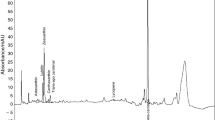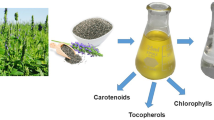Abstract
The oil extracted from the fat-storage organ (fat body) of the bullfrog (Rana catesbeiana) was characterized for its fatty acid composition. The main fatty acids were palmitic (18.1%), stearic (4.1%), myristic (2.7%), oleic (31.7%), and linoleic (12.9%) acids. Long-chain polyunsaturated fatty acids were also present in significant amounts, i.e., eicosapentaenoic (1.5%) and docosahexaenoic (4.7%), and were probably derived from the fish meal content of the diet. A partially fractionated oil was extracted from the homogenized and frozen fat body with an oleic acid content of 43.2%. The natural alkaloid boldine, added at 0.5 mg/g oil level, improved the oxidative stability by a factor ranging from 1.7 to 2.4, as assessed by the Oil Stability Index method between 90 and 110°C. The stabilization effect of boldine was higher than that of naringenin, morin, and quercitin and for the synthetic antioxidant butylated hydroxytoluene at the same concentration level.
Similar content being viewed by others
References
Lombourdis, N.S., and P. Kyriakopoulou-Sklavounou, Reproductive and Lipid Cycles in the Male Frog Rana rubibunda in Northern Greece, Comp. Biochem. Physiol. 99A:577–583 (1991).
Scapin, S., P. Baldini, and P. Luly, Phospholipid and Fatty Acid Composition of Frog (Rana esculenta) Liver, A Circannual Study, Lipids 25:443–449 (1990).
Gunstone, F.D., The Lipid Handbook, Chapman & Hall, London, 1986, pp. 571.
Official Methods and Recommended Practices of the American Oil Chemists’ Society, 4th edn., edited by D. Firestone, AOCS, Champaign, 1990.
Ackman, R.G., Simplification of Analyses of Fatty Acids in Fish Lipids and Related Lipid Samples, Acta Med. Scand. 222:99–103 (1987).
Standard Methods for the Analysis of Oils, Fats, and Derivatives, 7th edn., edited by C. Paquot and A. Hautfenne, Blackwell Scientific Publications, IUPAC, Oxford, 1987.
Speisky, H., B.K. Cassels, E. Lissi, and L. Videla, Antioxidant Properties of the Alkaloid Boldine in Systems Undergoing Lipid Peroxidation and Enzyme Inactivation, Biochem. Pharmacol. 41:1575–1581 (1991).
Méndez, E., J. Sanhueza, H. Speisky, and A. Valenzuela, Validation of the Rancimat Test for the Assessment of the Relative Stability of Fish Oils, J. Am. Oil Chem. Soc. 73:1033–1037 (1996).
Demczylo, V., J. Geille, and V. Martínez, Estadística, Ediciones de la Universidad de la República, Montevideo, Uruguay, 1984, pp. 123.
Méndez, E., Estudio de los Lípidos Extraídos de Pescados de Interés Nacional y de sus Posibles Aplicaciones, M.Sc. Thesis, Universidad de la República, Montevideo, Uruguay, 1993, pp. 143.
Ackman, R.G., Animal and Marine Lipids, in Technological Advances in Improved and Alternative Sources of Lipids, edited by B.S. Kamel and Y. Yakuda, Blackie Academic & Professional (1994), pp. 292–328.
Carballal, C., I. Jachmanián, and M. Lagos, Producción de Aceite de Hígado de Merluza de Calidad Comestible. Proyecto Industrial, Facultad de Ingeniería, Universidad de la República, Montevideo, Uruguay, 1992, pp. 232.
Litchfield, C., Analysis of Triglycerides, Academic Press, New York, 1972, pp. 248–251.
Das, N.P., and T.A. Pereira, Effects of Flavonoids on Thermal Autoxidation of Palm Oil: Structure-Activity Relationships, J. Am. Oil Chem. Soc. 67:255–257 (1990).
Rojas, E., Protección de ácidos grasos poliinsaturados mediante antioxidantes de origen natural, M.Sc. Thesis, Universidad Metropolitana, Santiago, Chile, 1994, pp. 47.
Nieto, S., A. Garrido, J. Sanhueza, L.A. Loyola, G. Morales, F. Leighton, and A. Valenzuela, Flavonoids as Stabilizers of Fish Oil: An Alternative to Synthetic Antioxidants, J. Am. Oil Chem. Soc. 70:773–778 (1993).
Ratty, A.K., and N.P. Das, Effects of Flavonoids on Nonenzymatic Lipid Peroxidation: Structure-Activity Reslationship, Biochem. Med. Metab. Biol. 39:69–79 (1988).
Valenzuela, A., S. Nieto, B.K. Cassels, and H. Speisky. Inhibitory Effect of Boldine on Fish Oil Oxidation, J. Am. Oil Chem. Soc. 68:935–937 (1991).
Cederbaum, A., E. Kulielka, and H. Speisky, Inhibition of Rat Liver Microsomal Lipid Peroxidation by Boldine, Biochem. Pharmacol. 44:1765–1772 (1992).
Hasenhuettl, G.L., and P.J. Wang, Temperature Effects of the Determination of Oxidative Stability with the Metrohm Rancimat. Ibid.:525–527 (1992).
Reynhout, G., The Effect of Temperature on the Induction Time of a Stabilized Oil, Ibid.:983–984 (1991).
Namiki, M., Antioxidants/Antimutagens in Food, Crit. Rev. Food Sci. Nutr. 29:273–300 (1990).
Author information
Authors and Affiliations
Corresponding author
About this article
Cite this article
Méndez, E., Sanhueza, J., Nieto, S. et al. Fatty acid composition, extraction, fractionation, and stabilization of bullfrog (Rana catesbeiana) oil. J Amer Oil Chem Soc 75, 79–83 (1998). https://doi.org/10.1007/s11746-998-0012-0
Received:
Accepted:
Issue Date:
DOI: https://doi.org/10.1007/s11746-998-0012-0




